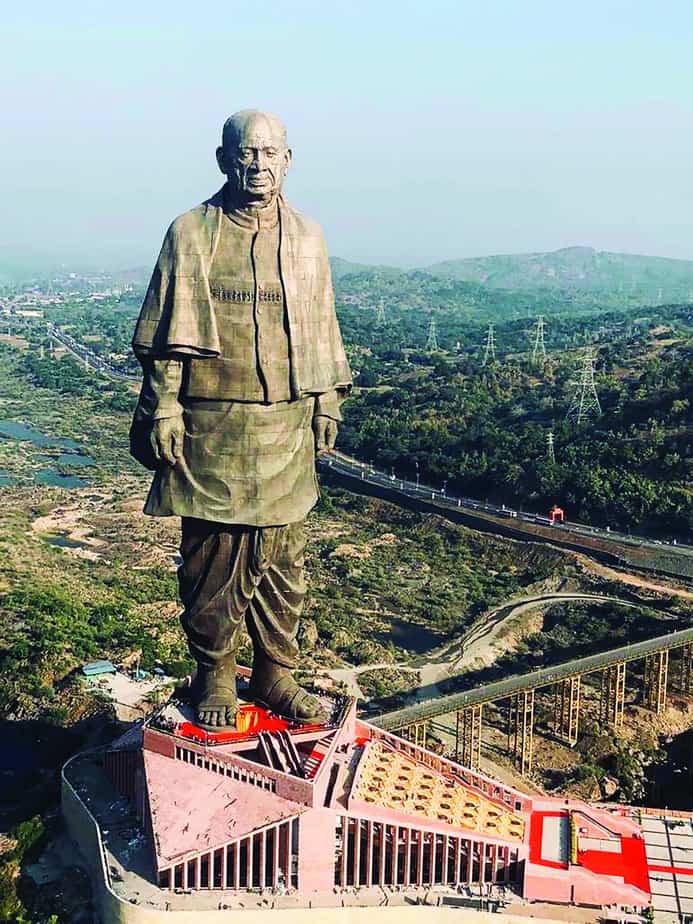
Earlier this week, Prime Minister Narendra Modi inaugurated the gigantic statue of Sardar Patel on his birth anniversary.
Known as the Statue of Unity, it’s 182 metres tall and by far the tallest statue in the world. An engineering marvel, the statue was completed in a record time of 33 months, with 3,400 people working tirelessly, at a cost of Rs 2,989 crore.
Almost twice as tall as the Statue of Liberty, it has been built by Larsen & Toubro; 1,700 tonnes of bronze and 1,850 tonnes of bronze cladding were employed to make the exterior. The core is made of concrete pillar reinforced by steel (18,500 tonnes). Two high-speed passenger elevators transport tourists to a huge viewing gallery around the chest area, which can accommodate 200 tourists at a time.
Noida-based sculptor Ram V Sutar designed this statue that can withstand winds of almost 180 km/h and earthquakes measuring 6.5 on the Richter scale. To accomplish a mega-project of this nature in a record time, requires strong political will and that was displayed by none other than PM Modi himself. A statue invariably becomes the most distinguishable landmark for any place, like the Statue of Liberty off the New York coast is the potent symbol of freedom and democracy all over the world.
It’s interesting to note that most of the bigger statues are dedicated to a mythical figure or prophets. In this regard, the Statue of Unity is a notable exception, as it is of a modern icon — the iron man of India, who was the first home minister of independent India and is remembered for facilitating the consolidation of various princely states into one cohesive nation—India.
While the nation celebrates the creation of a modern symbol of India’s nationhood, it would be interesting to look at the story of the making of Statue of Liberty, which took about 20 years to be built, 130 years ago. It was built by the French to celebrate their friendship with the United States and the abolition of slavery in the centenary year of American independence.
Frédéric Bartholdi, a young artist and architect from Paris, designed the statue, which he initially visualised for the entrance of the Suez Canal. He was helped by French engineer Gustave Eiffel, who was responsible for making its frame. The lack of resources delayed the completion by many years. France was responsible for the making of the statue, while the US took care of finding a suitable site—a small island in the New York harbour—and construction of a mountainous pedestal.
Just the making of the statue took eight long years. Completed in 1884, it is made of 350 prefabricated parts bound together around a pylon, 92 ft in height. Copper of 2.3 mm thickness forms the outer layer of the statue—the width just twice of a Euro coin, but in all weighs about 225 tonnes — was sourced from the mines in Norway. It was the greatest engineering feat of its time, credited for the largest use of copper and steel for a structure.
Initially, it remained in central Paris for a year and was later dismantled, packed in 214 crates and transported by sea to New York in a French Navy vessel called Isere.
The making of the pedestal was the responsibility of the Americans, the money was to be collected via donations and the kitty wasn’t full. It was only after the intervention of Joseph Pulitzer, a renounced newspaper publisher of New York, that an additional $1,00,000 were collected, 80 per cent of which were in the form of donations less than a dollar. The statue was installed finally in 1886, with certain flexibility incorporated in the structure to brave sea breeze.
The Statue of liberty is the symbol of the American dream. “From where I stood, the Statue of Liberty was a fluorescent green fleck against the sky, and beyond her sat Ellis Island, the focus of so many myths; but it had been built too late for those early Africans — who weren’t immigrants in any case — and it was closed too soon to mean anything to the later Africans like Kenneth, or the cabdriver, or me,” wrote Teju Cole, an American writer, photographer and art historian.
May the Statue of Unity inspire an equitable society in India where there’s no discrimination on the basis of caste or faith.
The Delhi and District Cricket Association spent over Rs 10 crore on litigation and professional…
The authorised representative of Castrol Ltd. joined the raid and confirmed that the seized products…
Commuters have been advised to avoid certain roads between 12 noon and 11 pm on…
During a search of their vehicle, police found 1.068 kg of charas, 98 grams of…
The alleged assault is linked to a dispute over some staff members allegedly cutting the…
This will play a decisive role in providing villagers with legal proof of ownership and…